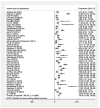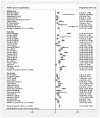The emergence of Clostridium difficile infection in Asia: A systematic review and meta-analysis of incidence and impact
- PMID: 28463987
- PMCID: PMC5413003
- DOI: 10.1371/journal.pone.0176797
The emergence of Clostridium difficile infection in Asia: A systematic review and meta-analysis of incidence and impact
Abstract
Background: Clostridium difficile infection (CDI) is the most common healthcare associated infection and is highly prevalent in Europe and North America. Limited data is available on the prevalence of CDI in Asia. However, secular increases in prevalence of risk factors for CDI suggest that it may be emerging as a major cause of morbidity, highlighting the urgent need for a systematic study of the prevalence of CDI in Asia.
Methods: We systematically searched PubMed/Medline and Embase for publications from Asia between 2000-16 examining prevalence of CDI. A random-effects meta-analysis was performed to calculate the pooled prevalence of CDI in Asia and to identify subgroups and regions at high risk.
Results: Our meta-analysis included 51 studies from throughout Asia including 37,663 patients at risk among whom confirmed CDI was found in 4,343 patients. The pooled proportion of confirmed CDI among all patients with diarrhea was 14.8% with a higher prevalence in East Asia (19.5%), compared with South Asia (10.5%) or the Middle East (11.1%). There were an estimated 5.3 episodes of CDI per 10,000 patient days, similar to rates reported from Europe and North America. Infections due to hypervirulent strains were rare. CDI-related mortality was 8.9%.
Conclusions: In a meta-analysis of 51 studies, we observed similar rates of CDI in Asia in comparison to Europe and North America. Increased awareness and improved surveillance of Clostridium difficile is essential to reduce incidence and morbidity.
Conflict of interest statement
Figures




References
-
- Barbut Fea. Clostridium difficile infection in Europe: a CDI Europe report 2013. http://www.multivu.com/assets/60637/documents/60637-CDI-HCP-Report-origi....
-
- Agency) PHEfHP. Mandatory surveillance of Clostridium difficile. 2012. http://www.hpa.org.uk/web/HPAweb&HPAwebStandard/HPAweb_C/1179746015058.
Publication types
MeSH terms
Grants and funding
LinkOut - more resources
Full Text Sources
Other Literature Sources

